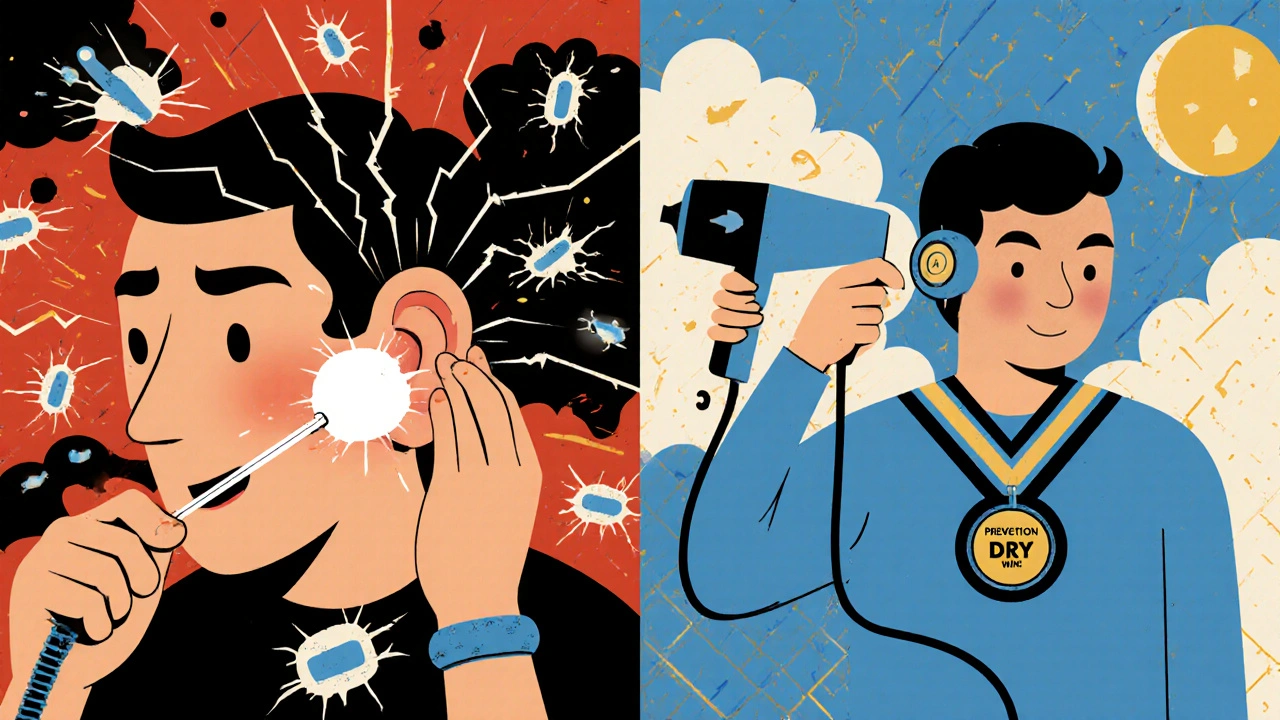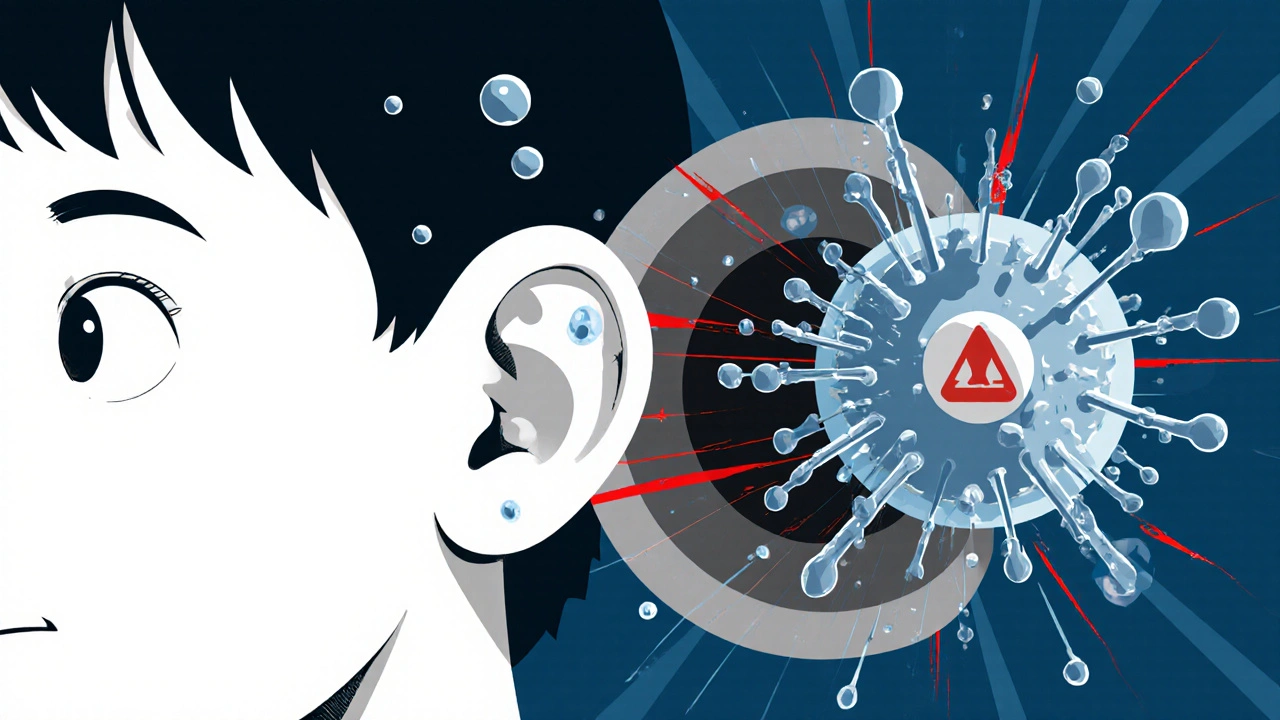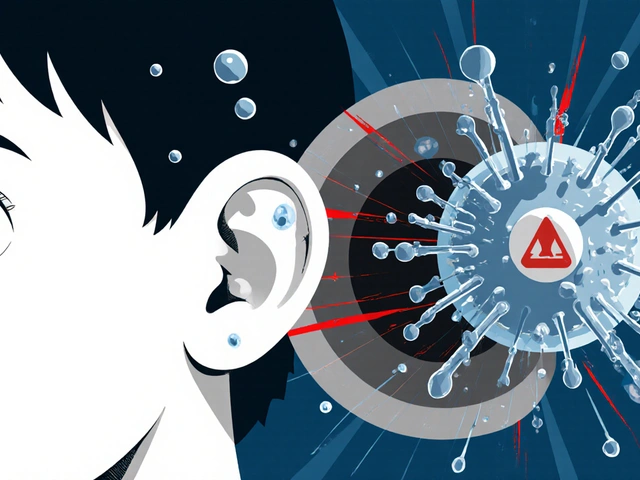Swimmer’s ear isn’t just a nuisance-it’s a painful, common infection that can knock you out of the pool, the shower, or even your job for days. If you’ve ever felt that sharp, throbbing pain when you tug on your earlobe, or noticed a strange discharge after swimming, you’re not alone. Every year, over 2.4 million people in the U.S. visit a doctor because of it. And while it’s called "swimmer’s ear," you don’t even need to swim to get it. All it takes is moisture trapped in the ear canal, a little scratch from a cotton swab, or a skin condition like eczema to turn your ear into a breeding ground for bacteria.
What Exactly Is Otitis Externa?
Otitis externa, or swimmer’s ear, is an infection of the outer ear canal-the tube that runs from your eardrum to the outside of your head. It’s not the same as a middle ear infection (otitis media), which happens behind the eardrum. This one is all about the skin lining that canal. When water stays in there too long, especially after swimming or even showering, it softens the skin and washes away its natural protective oils. Bacteria like Pseudomonas aeruginosa or Staphylococcus aureus move in fast. In 98% of cases, that’s all it takes to trigger an infection.
The symptoms are hard to miss. Severe ear pain-so bad that even touching your ear or chewing can make it worse-is the #1 sign. You’ll likely notice drainage too. At first, it’s clear or watery. Within a day or two, it turns yellow or green and thickens into pus. Many people also feel like their hearing is muffled. That’s not just in their head-audiometric tests show a real 20-30 decibel drop in hearing during active infection. And if you press on the tragus (the small flap right in front of your ear canal), and it hurts like hell? That’s the tragus test, and it’s 94% accurate at confirming swimmer’s ear.
Who’s Most at Risk?
It’s not just competitive swimmers. Kids between 7 and 12 make up 43% of cases. Teens and young adults aged 15 to 25 account for another 31%. Men are diagnosed more often than women-58% of cases. Why? It’s not about gender. It’s about behavior.
Swimming more than four days a week? That increases your risk by over seven times. Using cotton swabs, bobby pins, or even your fingernail to clean your ears? That’s behind 65% of cases caused by injury to the ear canal. People with eczema or psoriasis are also at higher risk-28% of chronic cases involve these skin conditions. Even wearing hearing aids or earbuds for long periods can trap moisture and irritate the skin.
The worst part? Most people who get it once will get it again. Studies show 87% of people with three or more episodes in a year are still poking or prodding their ears after being told not to. It’s not ignorance-it’s habit. And habits are hard to break.
How It’s Treated: What Actually Works
Thankfully, swimmer’s ear is highly treatable-if you catch it early and treat it right. The gold standard is topical antibiotic ear drops. The most effective are fluoroquinolone-based drops like ciprofloxacin 0.3% with hydrocortisone 1% (brand name Cipro HC). These aren’t just antibiotics-they also reduce swelling and inflammation. In clinical trials, this combo cleared up the infection in 92.4% of patients within seven days.
How to use them correctly matters more than you think. First, warm the bottle in your hand for a minute. Cold drops can make you dizzy. Lie on your side with the affected ear up. Pull your earlobe up and back (for adults) or down and back (for kids) to straighten the canal. Put in 10 drops. Stay lying there for five full minutes. This lets the medicine soak in instead of dripping out. Then, let it drain naturally. Don’t plug it with cotton.
For fungal infections (only about 2% of cases), clotrimazole 1% drops are used instead. These take longer-14 days-but work just as well.
Pain relief is critical. Mild pain? Acetaminophen at 15 mg per kg of body weight every 6 hours usually does the trick. But if the pain is severe-68% of cases-your doctor might prescribe oxycodone at 0.15 mg per kg every 4-6 hours. Don’t skip this. Uncontrolled pain delays recovery and makes sleep impossible.
Here’s the kicker: if you don’t keep your ear dry during treatment, your chance of failure jumps from 28% to 63%. That means no swimming. No showers without protection. No earbuds. No cotton swabs. Period.

Prevention: The Real Game-Changer
Most cases are preventable. And the cheapest, simplest method is a homemade solution: 70% isopropyl alcohol mixed with 30% white vinegar. Use a dropper to put a few drops in each ear after swimming or showering. Let it sit for 30 seconds, then tilt your head to drain. This mixture dries out moisture and creates an acidic environment that kills bacteria. A 2022 study of 1,200 swimmers showed this cut infection rates by 72%.
For serious swimmers, custom silicone earplugs are worth the $45-$120 price tag. They reduce moisture buildup by 68%. Over-the-counter foam plugs? Only 42% effective. And they often fall out or trap water inside.
Another simple trick? After swimming, use a hairdryer on the coolest setting, held about 12 inches away. Blow gently into the ear for 30 seconds. One Reddit user with four years of recurrent infections swears this stopped it cold. And it’s free.
Don’t clean your ears with anything. Your ear canal cleans itself. Earwax is protective. If you feel blocked, see a professional. Never stick anything smaller than your elbow in there.
What Not to Do
Stop using cotton swabs. Seriously. Every time you push one in, you’re scraping the delicate skin and pushing wax deeper. That’s why 65% of cases are iatrogenic-caused by the treatment itself.
Don’t assume it’s a middle ear infection. Doctors misdiagnose swimmer’s ear as otitis media 25% of the time. That means giving you the wrong medicine-oral antibiotics that don’t reach the outer canal. You’ll feel worse, not better.
Don’t ignore it. If you wait too long, the infection can spread. In rare cases, it can lead to necrotizing otitis externa-a dangerous infection that eats through bone. It’s uncommon, but it happens mostly in older adults with diabetes or weakened immune systems.

What’s New in Treatment
Science is moving fast. A new FDA-approved device called the ClearSee hydrogel ear wick was introduced in January 2023. It’s a tiny sponge-like strip placed in the ear canal by a doctor. It slowly releases antibiotics for days, even when the canal is swollen shut. In trials, it kept drug levels 300% higher than regular drops.
There’s also promising research into microbiome-sparing treatments. Instead of killing everything, scientists are testing therapies using harmless bacteria like Staphylococcus hominis to crowd out the bad bugs. Early results suggest it could cut recurrence rates from 14% to under 7%.
Telehealth is helping too. Smartphone otoscopes like TytoCare let you take a picture of your ear canal and send it to a doctor. They’re 89% accurate-almost as good as an in-person exam. That means faster diagnosis, less waiting, and fewer trips to the ER.
When to See a Doctor
You don’t need to wait until you’re in agony. If you have any of these, call your doctor:
- Pain that doesn’t improve after 24-48 hours
- Drainage that’s thick, foul-smelling, or bloody
- Fever or swelling around the ear
- Difficulty hearing that doesn’t clear up
- Recurrent infections (three or more times a year)
Most cases can be handled by your primary care provider or an urgent care clinic. Emergency rooms cost over $300 per visit. Primary care? Around $120. And with telehealth, you can often get a diagnosis and prescription the same day.
Final Thoughts: Knowledge Is Your Best Defense
Swimmer’s ear is frustrating because it feels like bad luck. But it’s not random. It’s predictable. It’s preventable. The people who avoid it aren’t lucky-they’re careful. They dry their ears. They skip the Q-tips. They use the alcohol-vinegar rinse. They don’t guess. They act.
And if you do get it? Treat it fast. Use the right drops. Keep it dry. Don’t touch it. Follow the instructions. You’ll feel better in days, not weeks.
The real victory isn’t just getting better. It’s never getting it again.
Can swimmer’s ear go away on its own?
Sometimes, mild cases can improve without treatment, but it’s risky. Without proper care, the infection can worsen, spread, or become chronic. Most doctors recommend treatment because pain is severe, recovery is faster with drops, and complications like hearing loss or bone infection can occur. Don’t wait it out.
Is swimmer’s ear contagious?
No, swimmer’s ear isn’t contagious. You can’t catch it from someone else. But sharing earbuds, towels, or swim gear can transfer bacteria or fungi if they’re still wet. Clean your gear after use, and avoid sharing items that go in the ear.
Can I swim while I have swimmer’s ear?
No. Swimming or even submerging your head in water will delay healing and likely make it worse. Even if you use earplugs, water pressure can force moisture past them. Wait until your doctor says it’s safe-usually after symptoms are gone for 24-48 hours and the ear canal is dry.
Why do ear drops sometimes hurt when I put them in?
Cold drops can trigger dizziness or sharp pain because the inner ear is sensitive to temperature changes. Always warm the bottle in your hand for 1-2 minutes before use. Also, if your ear canal is very swollen or inflamed, any liquid touching it may sting briefly. That’s normal. If the pain lasts more than a minute or gets worse, call your doctor.
How long does swimmer’s ear last?
With proper treatment, most people feel better within 2-3 days and are fully healed in 7-10 days. Without treatment, it can last weeks or become chronic. If symptoms don’t improve after 48 hours of using drops, or if they get worse, you need to see a doctor. You might have a resistant strain or a fungal infection.
Can children get swimmer’s ear?
Yes, and they’re actually more likely to get it than adults. Kids aged 7-12 make up nearly half of all cases. Their ear canals are smaller, so even a little moisture or wax buildup can cause blockage. Always dry their ears after swimming, and never use cotton swabs. If your child complains of ear pain after swimming, don’t assume it’s a cold or ear infection-get it checked.








Chrisna Bronkhorst November 12, 2025
Swimmer’s ear is just nature’s way of punishing people who think cotton swabs are tools and not weapons. 65% of cases are self-inflicted? Yeah. You’re not a doctor. You’re not a surgeon. You’re just a guy with a Q-tip and a death wish.
Amie Wilde November 13, 2025
Alcohol vinegar mix works. I’ve used it for years. No more infections. Stop poking your ears.
Gary Hattis November 15, 2025
Look, I’m from Florida. We got pools, beaches, humidity, and kids who won’t stop diving into the water like it’s a sport. This post? Perfect. The alcohol-vinegar rinse is the real MVP. Cheap, effective, and doesn’t require a prescription. I started doing it after my daughter got it three times in one summer. Now? Zero. Zero infections. Just dry ears and happy swimming. Also, hairdryer on cool? Genius. Free. No side effects. Just air. Who knew?
And yes, the tragus test? If it hurts when you press that little flap? You already know. Don’t wait. Don’t ‘see if it gets better.’ Go get drops. You’ll thank yourself in 48 hours.
Esperanza Decor November 15, 2025
I used to think swimmer’s ear was just a myth people made up to avoid swimming. Then I got it after a shower. One minute I was fine, next minute I couldn’t sleep because my ear felt like it was full of hot glass. I didn’t even swim. Just got water stuck. That’s wild. The part about earwax being protective? Mind blown. I’ve been cleaning my ears since I was 12. I think I’ve been the problem this whole time.
Now I use the vinegar-alcohol thing religiously. And I bought those silicone plugs. Worth every penny. My ears haven’t felt this good in a decade.
Deepa Lakshminarasimhan November 15, 2025
Did you know the FDA approved that hydrogel wick because Big Pharma wanted to keep selling expensive drops? The real cure is just drying your ears. But they don’t make money off that. Also, the microbiome thing? They’re trying to replace bacteria with other bacteria. That’s not science. That’s playing god. And why are they pushing telehealth otoscopes? So you don’t have to see a real doctor. They want you to self-diagnose with your phone. Wake up.
Erica Cruz November 17, 2025
Wow. So much effort for something that’s literally just ‘don’t stick things in your ear.’ I’m exhausted just reading this. Why is this even a thing? Why do we need a 2000-word essay on not using Q-tips? This isn’t a medical breakthrough. It’s basic hygiene. You’re not special. Your ear doesn’t need you to clean it. Stop.
Johnson Abraham November 19, 2025
lol so the ‘gold standard’ is just drops? i thought it was gonna be like laser surgery or something. and why do they say ‘warm the bottle’ like its a baby bottle? i just put it in my pocket for a sec. also i use q-tips and i’m fine. maybe i’m just lucky. or maybe you guys are weak.
also why are there so many words for this? i got it once and i just took tylenol and ignored it. it went away. boom. done.
Shante Ajadeen November 20, 2025
I used to get this every time I swam. I felt so defeated. Then I tried the alcohol-vinegar mix after reading this exact post. One week later, I was swimming again. No pain. No fear. Just water. I wish I’d known this sooner. Seriously. Don’t wait until it’s unbearable. Try the rinse. It’s not magic. It’s just smart.
And if you’re scared to use it? Start with half the amount. Just a drop. You’ll be fine. Your ears will thank you.
dace yates November 21, 2025
Is there any data on whether the vinegar-alcohol mix affects the natural pH of the ear canal long-term? Or is that just a myth? I’m asking because I’ve been using it daily for months now.
Danae Miley November 22, 2025
The 72% reduction statistic from the 2022 study is misleading. The sample was skewed toward competitive swimmers who were already motivated to change behavior. The control group didn’t receive behavioral counseling, which likely influenced outcomes. Correlation ≠ causation.
Charles Lewis November 24, 2025
It is worth noting that the pathophysiology of otitis externa is not merely a function of moisture retention but also involves a complex interplay of microbial colonization, host immune response, and epithelial integrity. While the alcohol-vinegar solution is efficacious in many cases, its efficacy may be diminished in individuals with underlying dermatological conditions such as seborrheic dermatitis or allergic contact dermatitis, which may necessitate adjunctive topical corticosteroid therapy. Furthermore, the assertion that earwax is universally protective may be an oversimplification; cerumen composition varies significantly across populations and may be influenced by genetic, environmental, and dietary factors. Therefore, while the advice to avoid cotton swabs is sound, a more nuanced approach to ear hygiene should be considered in clinical practice.
Renee Ruth November 24, 2025
They don’t want you to know the truth. The real reason swimmer’s ear is so common? The water in public pools is laced with chlorine-resistant bacteria. The government knows. They’ve been covering it up since the 90s. And the ‘alcohol-vinegar’ fix? That’s just a distraction. They don’t want you fixing it yourself. They want you coming back for more drops. More visits. More money. Wake up.
Samantha Wade November 25, 2025
This is one of the most comprehensive, well-researched, and practical guides I’ve ever read on a common medical issue. You’ve taken a topic that’s usually dismissed as ‘just a minor earache’ and turned it into a life-changing resource. The detail on the tragus test, the drop technique, and the prevention protocol? Brilliant. I’m sharing this with every swimmer I know - including my 10-year-old. Thank you for making this so clear, so actionable, and so human.
Elizabeth Buján November 26, 2025
I used to think my ear pain was just ‘bad luck’ - like the universe was picking on me. But reading this made me realize it wasn’t luck at all. It was habit. I was the problem. I used Q-tips like they were magic wands. I thought I was cleaning. I was hurting. Now I don’t touch them. I just dry them. And I feel… lighter. Like I finally stopped fighting my own body. Maybe healing isn’t about fixing something broken. Maybe it’s just about stopping the damage.
Shante Ajadeen November 27, 2025
Just wanted to say - I saw your comment about the vinegar mix, and I started using it. It’s been two weeks. No pain. No fear. I even swam in a lake last weekend. I’m not sure I believed it would work… but it did. Thank you.